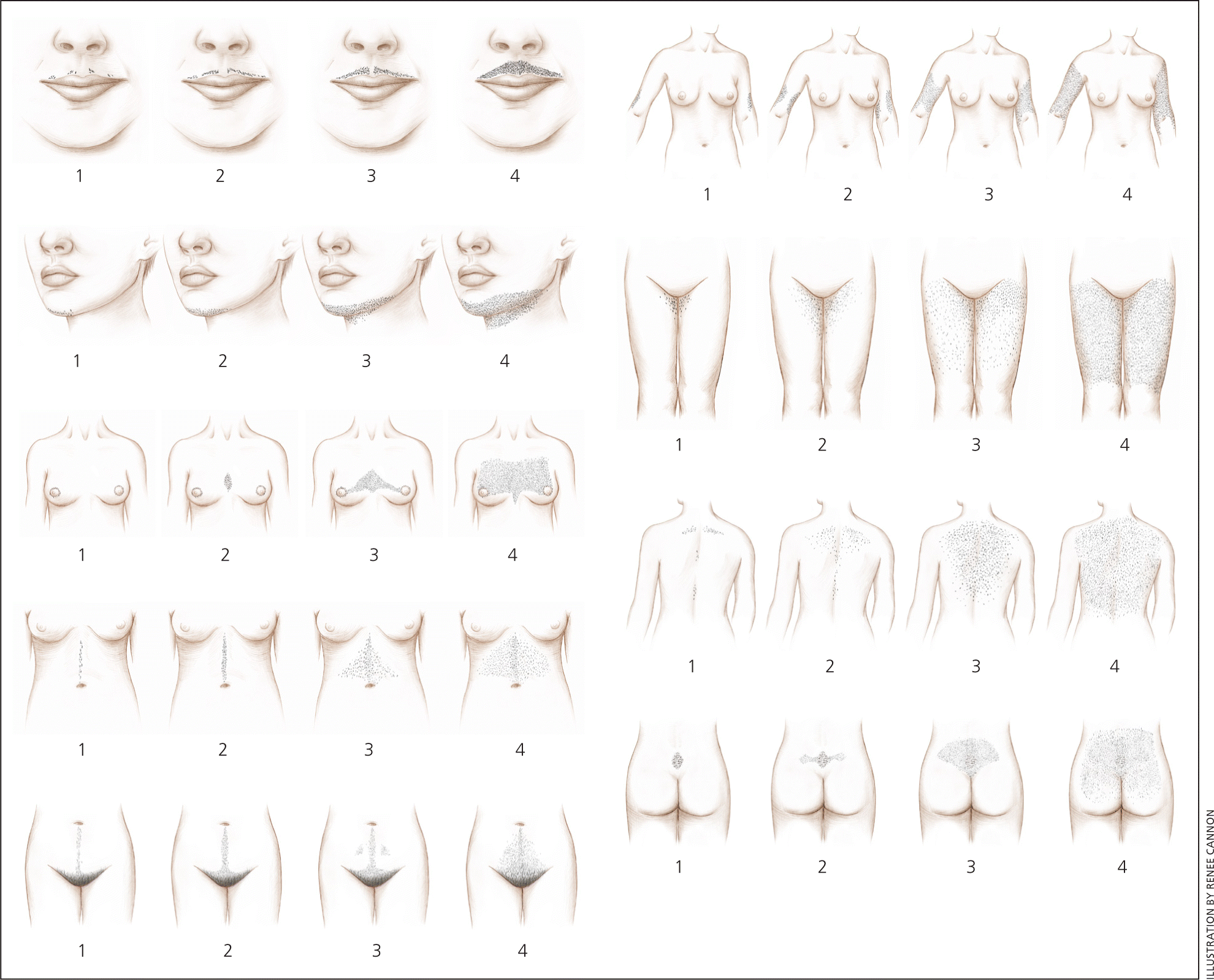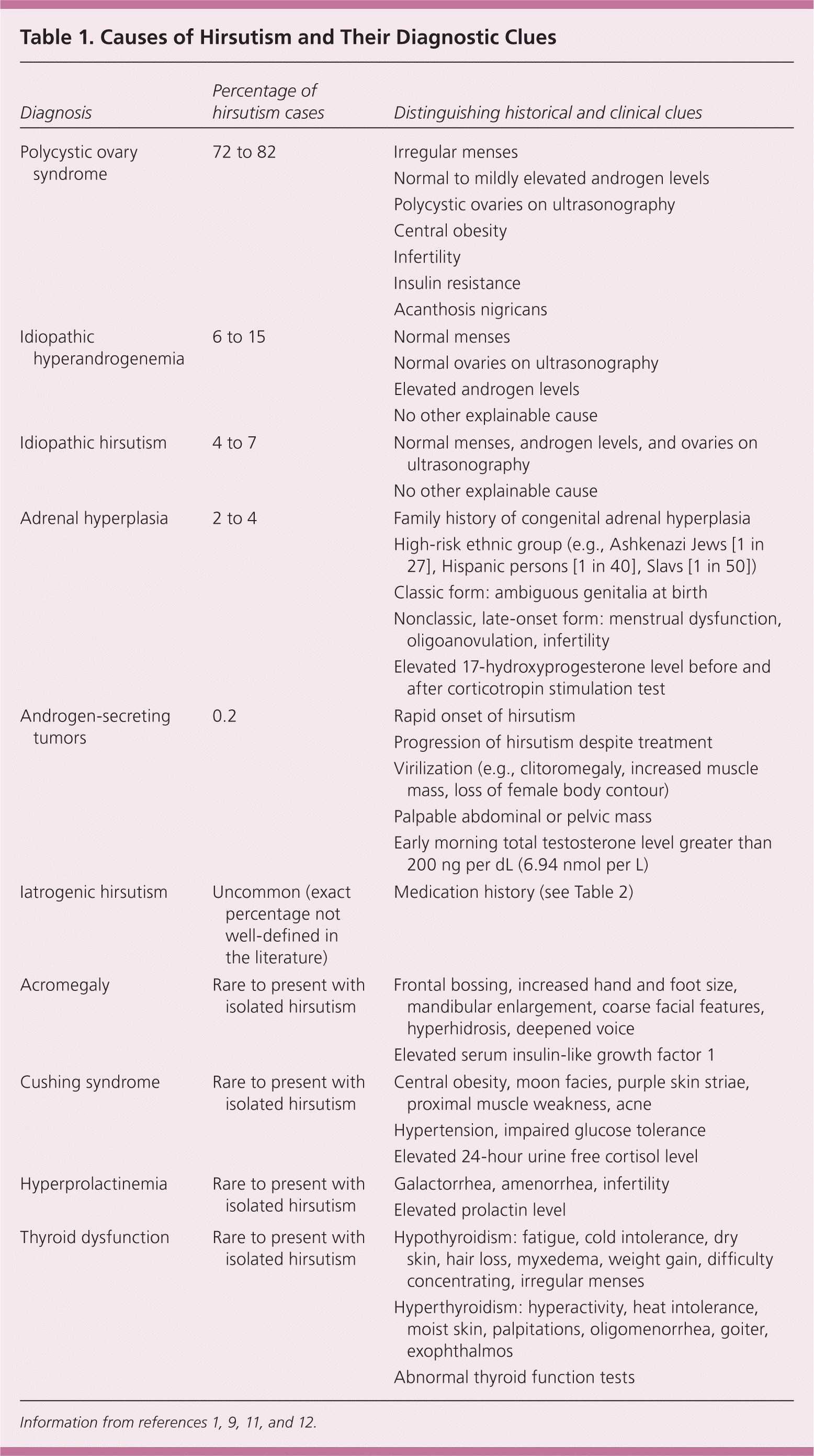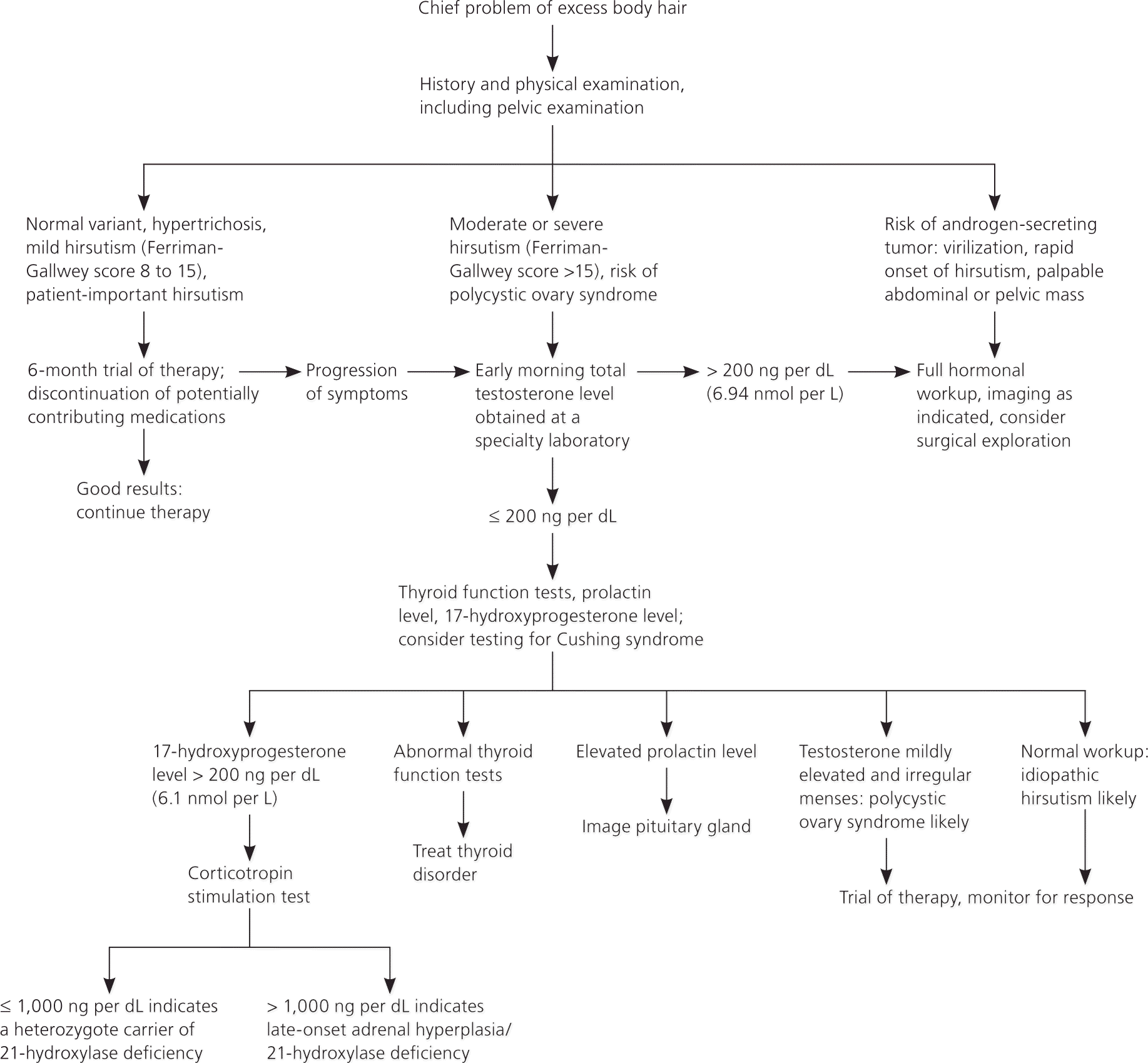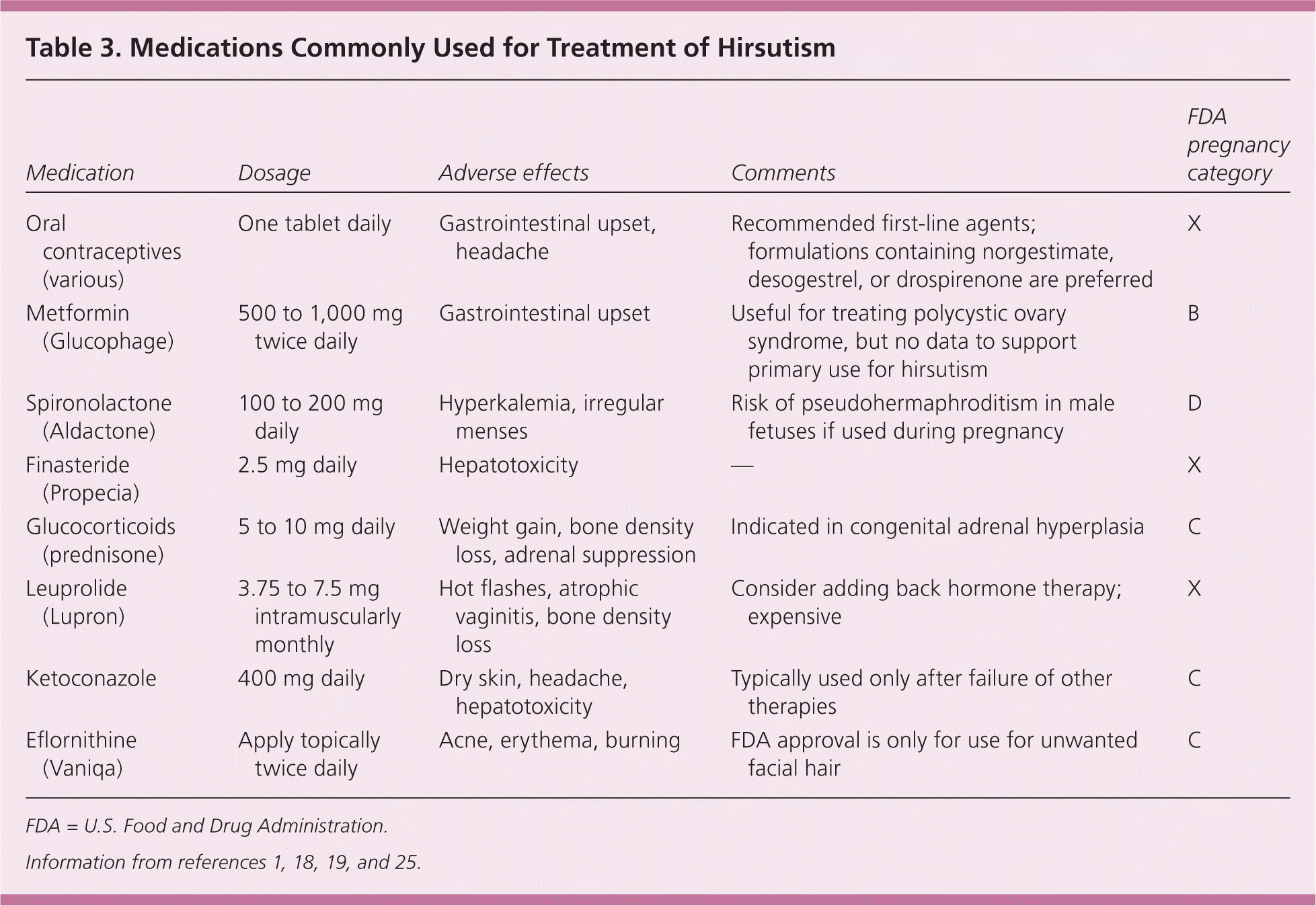
This is a corrected version of the article that appeared in print.
Am Fam Physician. 2012;85(4):373-380
Patient information: A handout on this topic is available at https://familydoctor.org/familydoctor/en/diseases-conditions/hirsutism.html.
Author disclosure: No relevant financial affiliations to disclose.
The views expressed in this article are those of the authors and do not reflect the policy or position of the U.S. Army Medical Department, Department of Army, Department of Defense, or the U.S. Government.
Hirsutism is excess terminal hair that commonly appears in a male pattern in women. Although hirsutism is generally associated with hyperandrogenemia, one-half of women with mild symptoms have normal androgen levels. The most common cause of hirsutism is polycystic ovary syndrome, accounting for three out of every four cases. Many medications can also cause hirsutism. In patients whose hirsutism is not related to medication use, evaluation is focused on testing for endocrinopathies and neoplasms, such as polycystic ovary syndrome, adrenal hyperplasia, thyroid dysfunction, Cushing syndrome, and androgen-secreting tumors. Symptoms and findings suggestive of neoplasm include rapid onset of symptoms, signs of virilization, and a palpable abdominal or pelvic mass. Patients without these findings who have mild symptoms and normal menses can be treated empirically. For patients with moderate or severe symptoms, an early morning total testosterone level should be obtained, and if moderately elevated, it should be followed by a plasma free testosterone level. A total testosterone level greater than 200 ng per dL (6.94 nmol per L) should prompt evaluation for an androgen-secreting tumor. Further workup is guided by history and physical examination, and may include thyroid function tests, prolactin level, 17-hydroxyprogesterone level, and corticotropin stimulation test. Treatment includes hair removal and pharmacologic measures. Shaving is effective but needs to be repeated often. Evidence for the effectiveness of electrolysis and laser therapy is limited. In patients who are not planning a pregnancy, first-line pharmacologic treatment should include oral contraceptives. Topical agents, such as eflornithine, may also be used. Treatment response should be monitored for at least six months before making adjustments.
Hirsutism is defined as excess terminal hair that commonly appears in a male pattern in women. It is generally associated with hyperandrogenemia.1 Hirsutism occurs in approximately 7 percent of women and has an estimated economic burden in the United States of more than $600 million annually.2,3 Hirsutism should be distinguished from hypertrichosis, which is generalized excessive hair growth not caused by androgen excess. Hypertrichosis may be congenital or caused by metabolic disorders such as thyroid dysfunction, anorexia nervosa, and porphyria.4
| Clinical recommendation | Evidence rating | References |
|---|---|---|
| Any patient with rapid onset of hirsutism, obvious signs of virilization, or a palpable abdominal or pelvic mass should undergo a thorough workup for a possible androgensecreting tumor. | C | 1, 18–20 |
| Women with mild hirsutism and normal menses do not require laboratory workup and can be treated empirically. | C | 1, 19 |
| First-line pharmacologic treatment of hirsutism in women not trying to conceive should include oral contraceptives. | C | 1, 19 |
Hirsutism is often classified in terms of the distribution and degree of hair growth, such as through pictorial scales. The most widely recognized scoring method is the Ferriman-Gallwey scale (Figure 1).5,6 [ corrected] This scale is limited by its subjective nature and its failure to account for all androgenic areas (e.g., sideburns, buttocks), focal hirsutism, ongoing use of cosmetic measures, or effect on patient well-being. Given these limitations, some experts recommend use of the term “patient-important hirsutism” to indicate symptoms significant enough to cause the patient distress, regardless of the degree of physical findings.1,7

Pathogenesis
Androgens, including testosterone, dihydrotestosterone, and their prohormones dehydroepiandrosterone sulfate and androstenedione, are the key factors in the growth and development of sexual hair. Androgens act on sex-specific areas of the body, converting small, straight, fair vellus hairs to larger, curlier, and darker terminal hairs.8 Men have higher androgen levels during and after puberty, and thus a greater degree of terminal hair development in sex-specific areas compared with women. Hirsutism develops in women when there is excessive growth of terminal hair in these areas, typically due to androgen excess.9
Causes

| Diagnosis | Percentage of hirsutism cases | Distinguishing historical and clinical clues |
|---|---|---|
| Polycystic ovary syndrome | 72 to 82 | Irregular menses |
| Normal to mildly elevated androgen levels | ||
| Polycystic ovaries on ultrasonography | ||
| Central obesity | ||
| Infertility | ||
| Insulin resistance | ||
| Acanthosis nigricans | ||
| Idiopathic hyperandrogenemia | 6 to 15 | Normal menses |
| Normal ovaries on ultrasonography | ||
| Elevated androgen levels | ||
| No other explainable cause | ||
| Idiopathic hirsutism | 4 to 7 | Normal menses, androgen levels, and ovaries on ultrasonography |
| No other explainable cause | ||
| Adrenal hyperplasia | 2 to 4 | Family history of congenital adrenal hyperplasia |
| High-risk ethnic group (e.g., Ashkenazi Jews [1 in 27], Hispanic persons [1 in 40], Slavs [1 in 50]) | ||
| Classic form: ambiguous genitalia at birth | ||
| Nonclassic, late-onset form: menstrual dysfunction, oligoanovulation, infertility | ||
| Elevated 17-hydroxyprogesterone level before and after corticotropin stimulation test | ||
| Androgen-secreting tumors | 0.2 | Rapid onset of hirsutism |
| Progression of hirsutism despite treatment | ||
| Virilization (e.g., clitoromegaly, increased muscle mass, loss of female body contour) | ||
| Palpable abdominal or pelvic mass | ||
| Early morning total testosterone level greater than200 ng per dL (6.94 nmol per L) | ||
| Iatrogenic hirsutism | Uncommon (exact percentage not well-defined in the literature) | Medication history (see Table 2) |
| Acromegaly | Rare to present with isolated hirsutism | Frontal bossing, increased hand and foot size, mandibular enlargement, coarse facial features, hyperhidrosis, deepened voice |
| Elevated serum insulin-like growth factor 1 | ||
| Cushing syndrome | Rare to present with isolated hirsutism | Central obesity, moon facies, purple skin striae, proximal muscle weakness, acne |
| Hypertension, impaired glucose tolerance | ||
| Elevated 24-hour urine free cortisol level | ||
| Hyperprolactinemia | Rare to present with isolated hirsutism | Galactorrhea, amenorrhea, infertility |
| Elevated prolactin level | ||
| Thyroid dysfunction | Rare to present with isolated hirsutism | Hypothyroidism: fatigue, cold intolerance, dry skin, hair loss, myxedema, weight gain, difficulty concentrating, irregular menses |
| Hyperthyroidism: hyperactivity, heat intolerance, moist skin, palpitations, oligomenorrhea, goiter, exophthalmos | ||
| Abnormal thyroid function tests |

| Hirsutism |
| Aripiprazole (Abilify) |
| Bimatoprost (Lumigan)* |
| Bupropion (Wellbutrin) |
| Carbamazepine (Tegretol) |
| Clonazepam (Klonopin) |
| Corticosteroids (systemic) |
| Cyclosporine (Sandimmune) |
| Dantrolene (Dantrium) |
| Diazoxide (Proglycem) |
| Donepezil (Aricept) |
| Estrogens |
| Eszopiclone (Lunesta) |
| Fluoxetine (Prozac) |
| Interferon alfa* |
| Isotretinoin |
| Lamotrigine (Lamictal) |
| Leuprolide (Lupron) |
| Mycophenolate (Cellcept)* |
| Olanzapine (Zyprexa) |
| Paroxetine (Paxil) |
| Pregabalin (Lyrica) |
| Progestins |
| Selegiline (Eldepryl) |
| Tacrolimus (Prograf)* |
| Testosterones |
| Tiagabine (Gabitril) |
| Trazodone |
| Venlafaxine (Effexor) |
| Zonisamide (Zonegran) |
| Hypertrichosis |
| Acitretin (Soriatane) |
| Azelaic acid (Finacea) |
| Cetirizine (Zyrtec) |
| Citalopram (Celexa) |
| Corticosteroids (topical) |
| Cyclosporine* |
| Etonogestrel implant (Implanon) |
| Phenytoin (Dilantin) |
POLYCYSTIC OVARY SYNDROME
The most common cause of hirsutism is polycystic ovary syndrome (PCOS), which accounts for 72 to 82 percent of hirsutism cases.9,11 PCOS is defined by the presence of at least two of the following three signs: menstrual dysfunction, clinical or biochemical evidence of hyperandrogenemia, and polycystic ovaries on ultrasonography. Other characteristics of PCOS include obesity, infertility, and insulin resistance. Insulin resistance and hyperinsulinemia stimulate the adrenal glands and ovaries to produce more androgens. Hyperinsulinemia also inhibits the hepatic synthesis of sex hormone–binding globulin, which binds testosterone and makes it inactive.14
IDIOPATHIC
Hirsutism is caused by idiopathic hyperandrogenemia in less than 20 percent of cases, and is characterized by normal ovulatory cycles and no other identifiable cause of elevated androgen levels.15 Idiopathic hirsutism, in which androgen levels are normal, accounts for 4 to 7 percent of cases and is a diagnosis of exclusion.9,11 One-half of all women with mild hirsutism (a Ferriman-Gallwey score of 8 to 15) have idiopathic hirsutism.16
ADRENAL HYPERPLASIA
Less than 5 percent of patients with hirsutism have adrenal hyperplasia, a defect in adrenal cortisol synthesis that diverts precursors into the androgen synthesis pathway. Classic adrenal hyperplasia is diagnosed at birth by ambiguous genitalia, but nonclassic adrenal hyperplasia can remain asymptomatic until after puberty, when women develop menstrual dysfunction and anovulation.17
ANDROGEN-SECRETING TUMORS
Androgen-secreting tumors are rare in women with hirsutism, comprising 0.2 percent of cases in two studies of women presenting with clinical hyperandrogenemia.9,11 Neoplasms may be adrenal or ovarian in origin, and often cause large elevations in androgen level. More than one-half are malignant. Rapid onset of hirsutism, virilization, or a palpable abdominal or pelvic mass all raise suspicion for an androgen-secreting tumor.1
OTHER CAUSES
Several other endocrinopathies can present with hirsutism but often have more distinctive presentations. These include acromegaly, Cushing syndrome, hyperprolactinemia, and thyroid dysfunction.1
Evaluation
The medical history should include a medication and supplement review. The patient should be asked if the excess hair growth began at puberty or after, and if its onset was rapid. A menstrual and reproductive history should also be obtained, as well as the hair patterns of family members (if possible) because idiopathic hirsutism is often familial.18 Patients should be asked if they have noticed changes in their voice, abdomen, breasts, skin, or muscle mass. It is also important to ask what hair removal measures have already been tried.

Physical examination should begin with determination of the distribution and degree of hair growth using a scoring method such as the Ferriman-Gallwey scale (Figure 1).5,6 The patient should be evaluated for signs of virilization, including clitoromegaly, acne, deep voice, balding, or loss of typical female body contours. An abdominal and bimanual examination should be performed to identify palpable tumors. A skin examination should check for acne, striae, or acanthosis nigricans. The patient's breasts should be examined for galactorrhea. Physicians should look for other typical signs of endocrinopathies, such as Cushing syndrome or thyroid dysfunction.
If possible, androgenic medications should be stopped. Any patient with rapid onset of hirsutism, obvious signs of virilization, or a palpable abdominal or pelvic mass should undergo a thorough workup for a possible androgen-secreting tumor.1,18–20 In contrast, patients with mild hirsutism and normal menses do not require laboratory workup and can safely be started on empiric therapy.1,19 If the condition does not respond to therapy or progresses, further testing is warranted.19
In patients with moderate or severe hirsutism or a history of possible PCOS, an early morning testosterone level should be obtained. Testosterone testing is inherently difficult, and specialty laboratories that employ proficiency testing using samples with known concentrations should be used if possible.20 A total testosterone level greater than 200 ng per dL (6.94 nmol per L) is indicative of an androgen-secreting tumor. Plasma free testosterone is 50 percent more sensitive than total testosterone, but because this testing is expensive and not widely available, it should be considered only if total testosterone levels are moderately elevated.19 Routine testing of other androgens, such as dehydroepiandrosterone sulfate, is not recommended, because mild elevations are common and have limited predictive value in the setting of normal testosterone levels.1
Further workup should include thyroid function tests, and prolactin and 17-hydroxyprogesterone levels. A urine free cortisol level, dexamethasone suppression test, or midnight cortisol level can be included if Cushing syndrome is suspected.21 If the 17-hydroxyprogesterone level is greater than 200 ng per dL (6.1 nmol per L), a corticotropin stimulation test should be performed to evaluate for adrenal hyperplasia.18 A patient with idiopathic hirsutism or a mild to moderately elevated testosterone level and an anovulatory history suggestive of PCOS should be treated appropriately and monitored for improvement.22
Little research has been done regarding hirsutism occurring outside of the peripubertal period. The onset of hirsutism in young children and postmenopausal women warrants further evaluation and subspecialty referral given the increased concern for neoplastic or secondary endocrine sources.
Treatment
Treatment of hirsutism should be guided by the severity of the condition and the amount of distress it is causing the patient. Additionally, the reproductive status of the patient and potential adverse effects should be factored into treatment decisions. Currently, there are no pharmacologic options indicated for pregnant women. Women desiring fertility may consider cosmetic hair removal.
Women who are obese should be encouraged to lose weight because obesity increases serum androgen levels and reduces the effectiveness of medical treatment.23
HAIR REMOVAL METHODS
Several methods of direct temporary hair removal are available. Shaving is fast, safe, and effective, but needs to be repeated often. Hair regrowth after shaving appears to be coarser, because the tip is blunt rather than tapered. Chemical depilation can be used to dissolve hairs, but can cause a reactive dermatitis.1 Epilation methods, such as waxing or plucking, remove hairs down to above the bulb; however, in addition to the discomfort of the procedure, scarring, folliculitis, and hyperpigmentation may occur.1
More permanent methods of hair removal include electrolysis, laser epilation, and photoepilation. Electrolysis, either galvanic or thermal, is painful and time-consuming because each hair follicle needs to be individually targeted. For this reason, electrolysis is a good option only for treating small areas of skin.1
Laser therapy is less painful and faster than electrolysis, and is widely believed to be more effective; however, it is also more expensive. A recent Cochrane review of hair removal methods found little evidence of their effectiveness.24 Alexandrite and diode lasers reduced hair by approximately 50 percent up to six months after treatment. Less evidence is available for short-term effects of pulsed light, neodymium: yttrium-aluminum-garnet (Nd:YAG), and ruby lasers, and none of these treatments have well-documented long-term outcomes.24 Laser epilation and photoepilation work best in women with light skin because less energy is required per pulse. Hyperpigmentation is a common adverse effect. Hair regrowth can occur in women with hyperandrogenemia through conversion of remaining vellus hair follicles into terminal hair.19
PHARMACOLOGIC METHODS

| Medication | Dosage | Adverse effects | Comments | FDA pregnancy category |
|---|---|---|---|---|
| Oral contraceptives (various) | One tablet daily | Gastrointestinal upset, headache | Recommended first-line agents; formulations containing norgestimate, desogestrel, or drospirenone are preferred | X |
| Metformin (Glucophage) | 500 to 1,000 mg twice daily | Gastrointestinal upset | Useful for treating polycystic ovary syndrome, but no data to support primary use for hirsutism | B |
| Spironolactone (Aldactone) | 100 to 200 mg daily | Hyperkalemia, irregular menses | Risk of pseudohermaphroditism in male fetuses if used during pregnancy | D |
| Finasteride (Propecia) | 2.5 mg daily | Hepatotoxicity | — | X |
| Glucocorticoids (prednisone) | 5 to 10 mg daily | Weight gain, bone density loss, adrenal suppression | Indicated in congenital adrenal hyperplasia | C |
| Leuprolide (Lupron) | 3.75 to 7.5 mg intramuscularly monthly | Hot flashes, atrophic vaginitis, bone density loss | Consider adding back hormone therapy; expensive | X |
| Ketoconazole | 400 mg daily | Dry skin, headache, hepatotoxicity | Typically used only after failure of other therapies | C |
| Eflornithine (Vaniqa) | Apply topically twice daily | Acne, erythema, burning | FDA approval is only for use for unwanted facial hair | C |
Combination oral contraceptives reduce serum free androgen levels by increasing sex hormone–binding globulin and inhibiting ovarian androgen production. The Endocrine Society recommends oral contraceptives as the first-line medication for women not trying to conceive.1 The few trials of oral contraceptives have shown a reduction in hirsutism over placebo or no therapy. Oral contraceptives containing the progestins norgestimate, desogestrel, or drospirenone are preferred because of their lower androgenic effects and/or their androgen blocking effects.1,23,26
The antiandrogens spironolactone (Aldactone), finasteride (Propecia), flutamide, and cyproterone (not available in the United States) have been shown to be effective treatments for hirsutism.1,23,27 Because of their teratogenic effects, they should be used only in women who cannot conceive or who are using birth control. The Endocrine Society recommends against the use of flutamide because of the possibility of liver failure.1
Insulin-lowering agents, such as metformin (Glucophage) and pioglitazone (Actos), have been suggested as alternative therapies. Although patients with PCOS are often treated with insulin-lowering agents to improve their insulin sensitivity and fertility, the evidence suggests that these medications provide little or no benefit for hirsutism symptoms and should not be used as a primary treatment for hirsutism.1,25,26
Eflornithine (Vaniqa) is a topical agent that reduces hair growth through inhibition of ornithine decarboxylase. When used for excess facial hair, results are noticed in about eight weeks. Eflornithine can be used alone or in conjunction with other therapies. Hair growth resumes after discontinuation.1,18
Other medications may be used in special cases. Gonadotropin-releasing hormone agonists are reserved for use in severe cases that have not responded to other therapies.1 Glucocorticoids are sometimes used in cases of nonclassic congenital adrenal hyperplasia.19 Ketoconazole has been suggested for patients in whom other therapies have failed.18
Any therapy for hirsutism should be continued for at least six months (the average life cycle of a hair follicle) before determining its effectiveness. If response at that time is inadequate, options include switching agents or using combination therapy. There is little evidence to suggest that combination therapy is superior to monotherapy.1
Data Sources: A PubMed search was completed in Clinical Queries using the key terms hirsutism, hypertrichosis, hyperandrogenemia/hyperandrogenism, hair removal, congenital adrenal hyperplasia, and polycystic ovarian syndrome. The search included meta-analyses, randomized controlled trials, clinical trials, and reviews. Also searched were the Cochrane database, Essential Evidence Plus, and the reference sections of cited articles. Search date: August 1, 2010.
